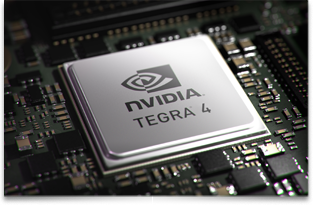
NVIDIA ha annunciato il nuovo SoC Tegra 4, una soluzione che il maker non esita a definire come il processore mobile più veloce al mondo, oltre che detentore di diversi primati anche nel campo del consumo di potenza, che sappiamo essere un aspetto particolarmente critico per gli smartphone, i tablet e le gaming machine portatili.
Ma il Tegra 4, fa sapere NVIDIA, è un prodotto indirizzato anche ai dispositivi per auto, ai sistemi di navigazione e agli stessi PC. NVIDIA promette, più in dettaglio, ottime prestazioni con le elaborazioni grafiche, una elevata velocità con il Web Browsing, una ottima qualità dell'output grafico e funzionalità avanzate nell'ambito fotografico.
Anche indicato con il nome in codice di "Wayne", il Tegra 4 include quattro core ARM Cortex-A15, un core aggiuntivo finalizzato alla riduzione del consumo di potenza (una soluzione analoga è stata introdotta la prima volta con il Tegra 3, ndr) e 72 GeForce GPU core; inoltre, con l'aggiunta di un chipset NVIDIA Icera i500 di quinta generazione (opzionale) è possibile abilitare il supporto dello standard 4G LTE.
In accordo a NVIDIA, il Tegra 4 ha una GPU sei volte più potente di quella del Tegra 3; inoltre, rispetto a quest'ultimo, consuma fino al 45% in meno.


NVIDIA today introduced NVIDIA Tegra 4, the world's fastest mobile processor, with record-setting performance and battery life to flawlessly power smartphones and tablets, gaming devices, auto infotainment and navigation systems, and PCs.
Tegra 4 offers exceptional graphics processing, with lightning-fast web browsing, stunning visuals and new camera capabilities through computational photography.
Previously codenamed "Wayne," Tegra 4 features 72 custom NVIDIA GeForce GPU cores -- or six times the GPU horsepower of Tegra 3 -- which deliver more realistic gaming experiences and higher resolution displays. It includes the first quad-core application of ARM's most advanced CPU core, the Cortex-A15, which delivers 2.6x faster web browsing and breakthrough performance for apps.
Tegra 4 also enables worldwide 4G LTE voice and data support through an optional chipset, the fifth-generation NVIDIA Icera i500 processor. More efficient and 40 percent the size of conventional modems, i500 delivers four times the processing capability of its predecessor.
"Tegra 4 provides enormous processing power and efficiency to power smartphones and tablets, gaming devices, auto systems and PCs," said Phil Carmack, senior vice president of the Tegra business at NVIDIA. "Its new capabilities, particularly in the area of computational photography, will help improve a whole range of existing products and lead to the creation of exciting new ones."
Computational Photography Capability
Among the Tegra 4 processor's breakthroughs is its Computational Photography Architecture, which automatically delivers high dynamic range (HDR) photos and video by fusing together the processing power of the GPU, CPU and the camera's image-signal processor.
Its HDR capability captures images, including those taken with a flash, the way they are seen by the human eye -- with detail in both bright and dark areas.
Unprecedented Power Efficiency
Designed for maximum energy efficiency, Tegra 4 includes a second-generation battery saver core for low power during standard use, and PRISM 2 Display technology to reduce backlight power while delivering superior visuals.
Tegra 4 consumes up to 45 percent less power than its predecessor, Tegra 3, in common use cases. And it enables up to 14 hours of HD video playback on phones.
Tegra 4 Key Features
- GeForce GPU with 72 custom cores
- Quad-core ARM Cortex-A15 CPU, plus a 2nd Generation Battery Saver Core
- Computational Photography Architecture
- LTE capability with optional Icera i500 chipset
- 4K ultra-high-def video support
Source: NVIDIA Press Release
Links



